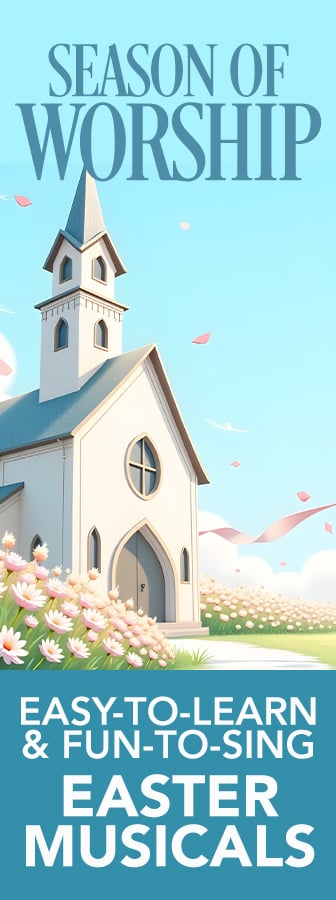In a previous post, we discussed the current wealth of worship music playing on the radio and the pressure that may put on local church music ministry. And that pressure to sound as good as the recording artist can lead us to another crucial error: singing the song in the wrong key.
What is the wrong key? More often than not, it’s the key on the radio.
Well, “wrong” is subjective. They chose the best key for that artist’s voice. Most of the time, the key that works best for the recording artist is not the best key for your congregation on Sunday morning.
Here are three songs currently at the top of the CCLI charts, along with the vocal range when sung in the original key:
- 10,000 Reasons by Matt Redman
- Key of G with a range of D (below middle C) up to F# (above middle C) - This Is Amazing Grace by Phil Wickham
- Key of Bb with a range of G (below middle C) up to G (above middle C) - Cornerstone by Hillsong
- Key of C with a range of C (below middle C) up to G (above middle C)
These songs are all too high for the average congregation. If you want to effectively use these songs, you’ll need to transpose them down to the right key.
But what is the right key? A few considerations will lead the way.
First and foremost, consider the vocal range of the congregation. Some suggest “C to shining C,” meaning a one octave range from C to C. If the song’s range is an octave or less, C to C is a great rule of thumb. But the melody in many songs (like #1 and #2 above) exceeds an octave. To accommodate, I would suggest expanding to an octave and a fourth range of A to D as the sweet spot for congregational singing. Most songs will fit within this range. Usually, simply adjusting the key to keep the melody in that A to D span will put you in safe territory for successful congregational singing.
The second consideration is tessitura, the musical term for “where most of the notes are.” Look over the entire song and evaluate where the melody tends to “live.” Even if the congregation stays within that A to D range, it can be strenuous if most of the notes are at one extreme for too long. They can reach that D, but if they stay up there continually, people will struggle and often drop down an octave — or drop out altogether.
But don’t over rotate! Bringing a song down too low is a danger as well. Singing down at the bottom of our range can drain the energy, especially if we sing down there for much of the song.
Also factor in the tempo of the song when judging tessitura. An up-tempo song may need to stay on the higher end. People will belt out higher notes when the energy of the song calls for it. Likewise, a quiet chorus may need to lean toward the lower end for comfortable warmth. We want to avoid a low tessitura for up-tempo pieces or a high tessitura for slower, quieter tunes.
With those ideas in mind, here are the right keys for those three songs above:
- 10,000 Reasons should be transposed down from G to Eb. That puts the melody from Bb up to a D, almost exactly our A to D range. And as a ballad, we want to keep the tessitura on the lower end. That high D only happens one time per chorus — we wouldn’t want a ballad to live up there too long.
- This Is Amazing Grace should be transposed down from Bb to F. That would keep the one octave melody between D and D. Why not “C to shining C?” Because this is an dynamic, up-tempo tune. We want to lean toward the top end to keep the energy high.
- Cornerstone should be transposed down from C to A. The melody stretches an octave and a fifth, so we’ll be singing from A up to an E here. But the tessitura of the first verse and chorus is low so we don’t want the song to lose energy before it gets to that power chorus. And that’s where we find that high E: it pops up just once but the song is really driving at that point. People will have energy to hit it, but it doesn’t require them to stay up there.
You may disagree with those decisions and make a case for a step higher or lower. The evaluation process is more art than science, and the makeup of your congregation should factor into the formula as well. (If you need help, the free online resource www.tranposr.com will transpose chord charts and mp3’s for you).
I believe the extra time and effort will payoff when you consistently, carefully place each worship song into the right key for your congregation. They may never know the time or technical skill required to find the right key, but they will learn to trust you as you lead them into worship.
Whether you're using these songs congregationally or setting these contemporary songs for worship choirs, I hope these suggestions have been useful.
--For more helpful articles about church music and worship service planning, check out www.discoverworship.com and these articles:
- The Critical Importance of Church Choirs
- 3 Steps Every Choir Director Should Take Now
- Improving Your Choir by Building the Blend
- 5 Things to Remember for Your Choir Rehearsal
- What's Better: Traditional Church Choir or Worship Team?
- 3 Ways to Cultivate Spirit-Led Worship
- Is There One Best Way to Format a Worship Set?
- How Often Should We Introduce New Congregational Worship Songs?
- Leading Worship Through Song List Curation
- 5 Tips to Grow Your Church Choir
- Is It Too Loud? (Accompaniment vs. Worship Emersion Culture)
- 8 Simple Hacks to Prevent Last Minute Choir Music Panic







